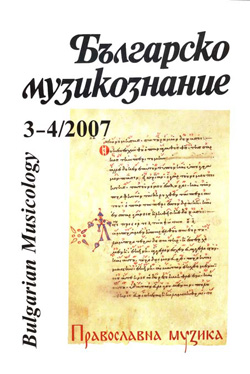Български полиелейни мелодии в късновизантийските извори от XIV-XV век
Bulgarian Polyeleos Settings in Late Byzantine Sources from the 14th - 15th Centuries
Author(s): Elena TonchevaSubject(s): Music
Published by: Институт за изследване на изкуствата, Българска академия на науките
Summary/Abstract: Intrigued by the thematic motif in the Vita of St. John Koukouzeles telling about the creation of the work Polyeleos of the Bulgarian Woman, which is said to have been inspired by his mother’s lamentations, Professor M. Velimirovich discovered in the Polyeleos repertory of late Byzantine manuscripts three melodies whose headings are connected with Bulgaria: the melody “e boulgara” (The Bulgarian Woman) in the first authentic mode (in the repertoire associated with Psalm 134) and two melodies called “boulgarikon” (Bulgarian) in the fourth and the second plagal modes (between the melodies for Psalm 135). In the first half of this report the melody “e boulgara” is traced in manuscripts from the 14th and 15th to the 17th 18th centuries, with comments about its various attributions: it was originally attributed to John Glykys, but from the end of the 16th century on was attributed to John Koukouzeles. The phonetic variants of the headings are also discussed. The melody used to sing various verses from Psalm 134, and it is especially frequently connected with verse 13b. The analysis in the context of the late Byzantine polyeleos repertoire reveals the periodic repetition of melodic sections in both of its parts. Special attention is given to development of the repeating melodic episode that modulates within the second authentic mode (through a corresponding sign for modal change phtora). The hypothesis is suggested that the appearance of the heading “The Bulgarian Woman” is due to this unusual episode in melodic development that adds a crying intonation and most probably “imitates Bulgarian lament” (which corresponds to Dokeian’s heading written above a kratema): thus, the “e boulgara” melody falls under the practice of intonational mimesis, characteristic for the period when musical manuscripts included headings connected with intonational realia (such as instrumental sounds or natural sounds). On the basis of this analysis, a melodic connection is sought between the Renaissance version Polyeleos of the Bulgarian Woman by John Koukouzeles (which underwentthe changes of musical “exegesis” in the post-Byzantine period) and the medieval melody “e boulgara.” The existence of a link between the heading and the thematic motif in the life of St. loan Kukuzel is accepted. The second half of this report traces in manuscripts from the same time the two others “Bulgarian” (boulgarikon) melodies. An analysis of these melodies in the context of polyeleos repertoire of Psalm 135 once again reveals the same compositional peculiarity: the existence of periodic repetition in the ordering of combined melodic episodes; this repetition is particularly clear in the “boulgarikon” melody in the second plagal mode, in which the series of melodic episodes is repeated four times. The definitions that also frequently accompanied these two melodies, dysikon “western” are also analyzed, as they also most probably refer to the region of the Balkans. The hypothesis is suggested..
Journal: Българско музикознание
- Issue Year: 2007
- Issue No: 3-4
- Page Range: 58-88
- Page Count: 31
- Language: Bulgarian
- Content File-PDF

